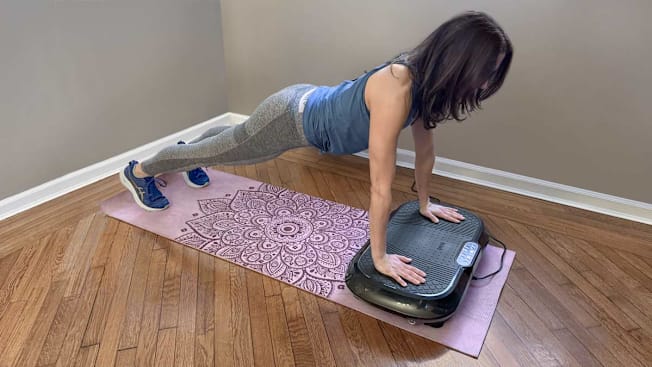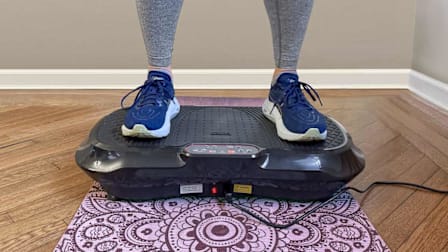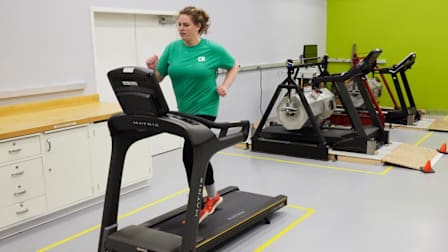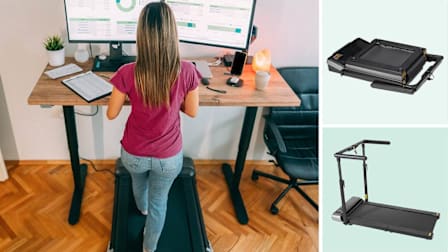What Do Experts Think of Vibration Plates?
We spoke with doctors to find out whether the trendy fitness device really works to improve health and wellness

Vibration plates are the Rorschach inkblot test of the moment no one asked for or saw coming.
To some, trendy vibration plates—at-home devices that provide high-frequency, whole-body vibrations and are said to stimulate muscle contractions and relaxation—are used by fitness diehards who will try almost anything for extra gains. Others (myself included) approach vibration plates cautiously, only to find their muscles and joints feel pretty good when utilizing them post-workout or as part of their fitness routine.
Do Vibration Plates Really Work?
Proponents of whole-body vibration claim it has several benefits, including fat burning, weight loss, improved flexibility, enhanced blood flow, reduced muscle soreness after exercise, more strength, and a decrease in the stress hormone cortisol, and some research shows that it may help improve balance, and reduce back pain and bone loss, according to the Mayo Clinic. Some early research has suggested that there is potential that whole-body vibration may improve cognition, but results are mixed, and any effect may not be noticeable in real-world settings.
Vibration plate coach Debby Pelletier became aware of whole-body vibration in 2007 while seeking a surgery-free alternative to her sustained knee injury. Pelletier claims that vibration plates reduced swelling in her knee and fatigued her muscles when she couldn’t exercise because of her injury. She credits the plates with helping her manage her injury and avoid knee replacement surgery.
Pelletier now works with clients in clinics, in gyms, and at home to help integrate vibration plates into their wellness journeys and fitness routines. She says she sees two categories of clients: those who use plates for fitness and those who use them for “symptom management.”
The former is easier to explain: Most of the vibration plates CR tested come with manuals advising on specific exercises enhanced by the additional challenge that oscillating vibration places on your muscles (exercises include squats, lunges, planks, and glute bridges). As I performed each exercise on a vibration plate for 15 minutes per session, I felt my muscles work harder to keep my body stable. There is no one solid recommendation about the minimum amount of time you should spend on a vibration plate, but 15 minutes a day, three times a week, is recommended by whole-body vibration advocates, according to the Mayo Clinic. Some of the machines we tested turned off automatically after just 10 minutes.
A Rheumatologist’s Take on Vibration Plates
One of the most significant claims about vibration plates is that they help regain lost bone mass. Some research—including a 2015 review published in Menopause Review and a 2020 study published in the Journal of Manipulative and Physiological Therapeutics—backs up claims that whole-body vibration can help rebuild bone, but the evidence isn’t conclusive.
Nancy E. Lane, MD, a rheumatologist at UC Davis and an expert in osteoporosis and osteoarthritis, tells CR that more rigorous clinical trials have not supported these claims, even though vibration plates have been around for more than 30 years.
However, she says, even though bone mineral density is essential, it doesn’t tell you about many other important things regarding musculoskeletal function, which is where vibration plates may be helpful. “It does most likely do some positive things if it vibrates on or stimulates the muscle to become stronger,” Lane says. “Stronger muscles prevent falls, and even though the bone mass doesn’t go up, the quality of the bone may be better if the vibration plate stimulates blood circulation through the bone.”
Check out the best vibration plates from our tests.
A Neurologist’s Take on Vibration Plates
“There is at best very weak research evidence for the use of whole-body vibration as a therapeutic intervention for any neurological disease that induces sensory or motor impairment, imbalance, alters walking or functional skills of the upper extremity, or impairs cognition,” Dobkin says. “The biological likelihood of a clinically important improvement seems quite low.”
The biggest hurdle has been a lack of well-designed studies of vibration plates that address the many variables in neurological conditions. For example, testing vibration plates with a person who suffered from stroke would require addressing their degree of weakness, location of the stroke, age, prior disability and medical problems, body weight, adequate balance to stand on a platform, duration of time since onset of stroke, etc., Dobkin says. In other words, studies of vibration plates tend to measure one factor or symptom instead of taking a more holistic approach.
“People want to believe that a passive ‘therapy’ will help them,” Dobkin says. “The industry takes off well before the evidence is established. It takes, however, repetitive, progressively challenging practice of the skills one wants to improve in a degraded nervous system to reduce disability and improve those sensory, motor, and cognitive skills.”
An Endocrinologist’s Take on Vibration Plates
Board-certified endocrinologist Karen Herbst, PhD, MD, is a lipedema expert who tells CR that many patients use vibration plates to reduce swelling and pain. Lipedema is a long-term condition in which an abnormal amount of fat builds up in specific parts of the body; lymphedema is also a chronic condition, but it is categorized by tissue swelling caused by an accumulation of lymphatic fluid. Both conditions can cause swelling and pain. According to Herbst, whole-body vibration may help because the vibration improves blood flow through the tissue, builds muscle, and improves lymphatic flow.
Although there are added benefits of exercising on a vibration board, Herbst says just standing on one and focusing the vibration on different body parts can help. “A good first step is just get on it, bend your knees so that you focus the vibration on the lower part of the body, and then start playing around with moving the vibration around on your body,” Herbst says.
Disclosure: In a 2021 blog post, vibration plate manufacturer Lifepro claimed to have a partnership with Herbst. However, both Herbst and Lifepro confirmed to CR that no such collaboration ever occurred and that Herbst did not receive any financial compensation from Lifepro. Lifepro stated that the blog post will be updated to accurately reflect this information.
Who Shouldn’t Use a Vibration Plate?
Vibration plates aren’t for everybody. On the blog University Hospitals, Jacob Calcei, MD, cautions against using vibration plates if you are pregnant, have implanted medical devices like pacemakers, have had recent injuries or surgeries, or have any of the following medical conditions:
- High blood pressure
- A history of heart attack or stroke
- Blood clotting disorder
- Severe osteoporosis
- Epilepsy or other seizure disorders
- An active infection
- A history of migraine headaches
- Vertigo
Additionally, children should not use vibration plates.




















